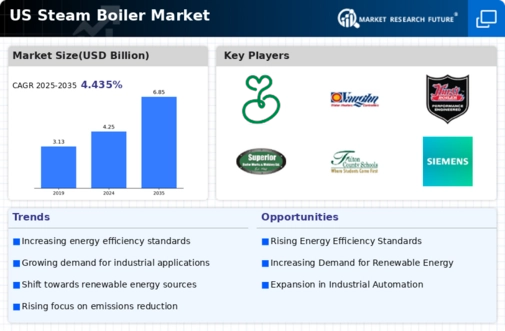Technological Innovations
Technological innovations play a pivotal role in shaping the steam boiler market, as manufacturers continuously seek to enhance performance and reliability. Recent advancements in boiler design, control systems, and materials have led to the development of more efficient and durable steam boilers. For example, the integration of IoT technology allows for real-time monitoring and predictive maintenance, which can significantly reduce downtime and operational costs. The market is also witnessing a trend towards modular boiler systems, which offer flexibility and scalability for various applications. According to industry estimates, the adoption of advanced boiler technologies could increase overall efficiency by up to 15%. As industries increasingly prioritize operational efficiency and reliability, the steam boiler market is likely to benefit from these technological advancements, driving growth and innovation in the sector.
Focus on Energy Efficiency
Energy efficiency remains a critical driver in the steam boiler market, as industries strive to minimize energy consumption and reduce greenhouse gas emissions. The US government has implemented various initiatives aimed at promoting energy-efficient technologies, which directly impacts the steam boiler market. For instance, the Energy Policy Act encourages the adoption of high-efficiency boilers, which can achieve efficiency ratings of over 90%. This regulatory push is likely to lead to a significant increase in the installation of energy-efficient steam boilers across various sectors. Additionally, companies are increasingly aware of the financial benefits associated with energy-efficient systems, as they can lead to substantial cost savings over time. As a result, the steam boiler market is expected to witness a shift towards more energy-efficient models, aligning with both regulatory requirements and corporate sustainability goals.
Increasing Industrial Demand
The steam boiler market experiences a notable surge in demand driven by the expanding industrial sector in the US. Industries such as food processing, pharmaceuticals, and chemicals rely heavily on steam boilers for various applications, including heating, sterilization, and power generation. According to recent data, the industrial sector is projected to grow at a CAGR of approximately 4.5% over the next five years, which is likely to bolster the steam boiler market. This increasing industrial activity necessitates efficient and reliable steam generation, thereby propelling the demand for advanced steam boiler technologies. Furthermore, the need for energy-efficient solutions in manufacturing processes is becoming more pronounced, as companies seek to reduce operational costs and enhance productivity. Consequently, the steam boiler market is poised to benefit from this industrial growth, as manufacturers invest in modernizing their steam generation systems.
Rising Environmental Concerns
Rising environmental concerns are influencing the steam boiler market, as industries face pressure to adopt cleaner technologies. The US is witnessing a shift towards sustainable practices, with many companies committing to reducing their carbon footprint. This trend is prompting a reevaluation of traditional steam generation methods, leading to increased interest in low-emission and renewable energy solutions. For instance, the use of biomass and waste heat recovery systems is gaining traction as viable alternatives to conventional fossil fuel-based boilers. The steam boiler market is likely to see a growing demand for systems that comply with stringent environmental regulations, as businesses aim to align with sustainability goals. Furthermore, the potential for government incentives for adopting greener technologies may further stimulate market growth, as companies seek to enhance their environmental credentials while maintaining operational efficiency.
Expansion of the Construction Sector
The expansion of the construction sector is a significant driver for the steam boiler market, as new buildings and infrastructure projects require efficient heating solutions. The US construction industry is projected to grow steadily, with an estimated increase of 5% annually over the next few years. This growth is likely to create a heightened demand for steam boilers in commercial and residential applications, particularly for heating and hot water systems. Additionally, the trend towards energy-efficient buildings is influencing the specifications for steam boiler installations, as builders seek to incorporate advanced heating technologies that meet modern energy standards. As the construction sector continues to thrive, the steam boiler market is expected to benefit from increased installations and retrofitting projects, further solidifying its position in the heating solutions landscape.






















Leave a Comment